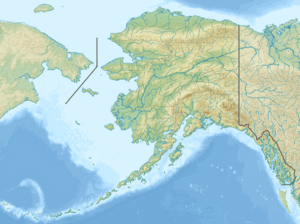Grand Central River facts for kids
Quick facts for kids Grand Central River |
|
|---|---|
|
Location of the mouth of the Grand Central River in Alaska
|
|
| Country | United States |
| State | Alaska |
| District | Nome Census Area |
| Physical characteristics | |
| Main source | Confluence of the stream's east and west forks Kigluaik Mountains, Seward Peninsula 693 ft (211 m) 64°58′06″N 165°14′16″W / 64.96833°N 165.23778°W |
| River mouth | Salmon Lake 28 miles (45 km) northeast of Nome 443 ft (135 m) 64°53′47″N 165°04′34″W / 64.89639°N 165.07611°W |
| Length | 12 mi (19 km) |
The Grand Central River is a cool waterway located on the Seward Peninsula in Alaska, a big state in the United States. This river flows into Salmon Lake from the west side.
What's interesting is that the Grand Central River and the Kruzgamepa River (also called Pilgrim River) are actually part of the same water system. However, they have different names and unique features. The Grand Central River flows into Salmon Lake, while the Kruzgamepa River flows out of it!
Contents
Exploring the Grand Central River
The Grand Central River is about 12 miles (19 km) (about 19 kilometres (12 mi)) long. It can also be about 2 miles (3.2 km) (about 3 kilometres (1.9 mi)) wide in some places.
Where the River Begins
The area that collects water for this river is almost completely surrounded by tall mountains. These are part of the Sawtooth Range, which is in the Kigluaik Mountains. These mountains can be very high, from 1,500 feet (460 m) (about 457 metres (1,499 ft)) to 4,000 feet (1,200 m) (about 1,219 metres (3,999 ft)) tall!
The river starts near the bottom of Mount Osborn. It begins at an elevation of about 700 feet (210 m) (about 213 metres (699 ft)). This is where its two main parts, the North and West forks, join together.
The River's Journey
From where it starts, the Grand Central River flows south. It eventually empties into Salmon Lake. As the river flows from its starting point to Salmon Lake, it drops about 300 feet (91 m) (about 91 metres (299 ft)) in elevation.
When there's a lot of water, like after heavy rain or melting snow, the river can spread out over a wide area of gravel. On both sides of the river, there's a small flat area of land. Then, the mountains rise up very steeply.
Streams Joining the River
Many smaller streams, called tributaries, flow into the Grand Central River. These streams add more water to the river as it travels.
From the east side, Gold Run and Rainbow Creek join the river. From the west side, you'll find Thompson, Thumit, Nugget, Jett, and Morning Call creeks. Most of these smaller streams flow through short, steep valleys. They get a lot of water from melting snow, especially in the warmer months.


